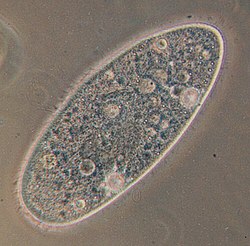
Back نواتح Arabic نواتح ARZ Diaphoretickes Azerbaijani Megagrup plantes+HC+SAR Catalan Diaphoretickes German Diaphoretickes Spanish Megagrupo plantas+HC+SAR Galician דיאפורטיקס HE Diaphoretickes Hungarian Diaphoretickes Interlingua
| Diaphoretickes Temporal range: [1]
| |
|---|---|
| Diaphoretickes diversity (clockwise from top left): sunflower (Archaeplastida), ciliate (Alveolata), kelp (Stramenopiles), cryptomonad (Cryptista), foram (Rhizaria), centrohelid (Haptista) | |
| Scientific classification | |
| Domain: | Eukaryota |
| Clade: | Diaphoretickes Adl et al., 2012[2] |
| Clades | |
Possibly included: | |
| Synonyms | |
Diaphoretickes (from Greek διαφορετικές (diaforetikés) 'diverse') is a major evolutionary lineage, or clade, of eukaryotic organisms spanning over 600,000 species. They comprise an enormous diversity of life forms, from single-celled protozoa to multicellular plants and numerous types of algae. The clade was discovered through phylogenetic analyses in the 21st century that revealed a close relationship between the supergroups Archaeplastida (or plants in a broad sense), Haptista, Cryptista, and SAR (Stramenopiles, Alveolata and Rhizaria).
Before molecular analyses recovered this clade, evolutionary biologist Thomas Cavalier-Smith had already hypothesized an evolutionary proximity between plants and the remaining groups (collectively known as 'chromalveolates' in his classification system). He coined the term photokaryotes for these organisms, as they include almost all of the photosynthetic eukaryotes. He later called them corticates due to the presence of cortical alveoli in many of their members.
Although Diaphoretickes contains organisms of very different morphologies, they have a few common traits. Ancestrally they are similar to excavates, with two flagella and a ventral feeding groove. In addition, the presence of cortical alveoli and flagellar hairs are interpreted as ancestral traits unique to the group. Some traits appeared convergently in many groups, such as the acquisition of chloroplasts through primary and secondary endosymbioses and the presence of axopodia and a heliozoan-type cell. In particular, chloroplasts with chlorophyll c and heliozoan cells are exclusive to Diaphoretickes.
Within Diaphoretickes, Cryptista and the heliozoan Microheliella maris form the clade Pancryptista, which is the closest relative to Archaeplastida, together forming the CAM clade. Haptista and SAR are closer to each other and to a clade of flagellates known as Telonemia. In addition, three small groups of protists, Provora, Hemimastigophora and Meteora sporadica, form a clade that may belong to Diaphoretickes.
- ^ Strassert, Jürgen F. H.; Irisarri, Iker; Williams, Tom A.; Burki, Fabien (25 March 2021). "A molecular timescale for eukaryote evolution with implications for the origin of red algal-derived plastids" (PDF). Nature Communications. 12 (1): 1879. Bibcode:2021NatCo..12.1879S. doi:10.1038/s41467-021-22044-z. ISSN 2041-1723. PMC 7994803. PMID 33767194. Retrieved 13 May 2025.
- ^ a b Cite error: The named reference
Adl-2012was invoked but never defined (see the help page). - ^ Lankester, E. Ray (September 1878). "Preface to the English translation". In Gegenbaur, Carl (ed.). Elements of Comparative Anatomy. London: MacMillan and co. p. xviii.
- ^ a b Cite error: The named reference
Cavalier-Smith-2015was invoked but never defined (see the help page). - ^ Cavalier-Smith, T (1 March 2002). "The phagotrophic origin of eukaryotes and phylogenetic classification of Protozoa". International Journal of Systematic and Evolutionary Microbiology. 52 (2): 297–354. doi:10.1099/00207713-52-2-297. ISSN 1466-5026.
- ^ Cite error: The named reference
Cavalier-Smith-2021was invoked but never defined (see the help page).
Cite error: There are <ref group=lower-alpha> tags or {{efn}} templates on this page, but the references will not show without a {{reflist|group=lower-alpha}} template or {{notelist}} template (see the help page).





